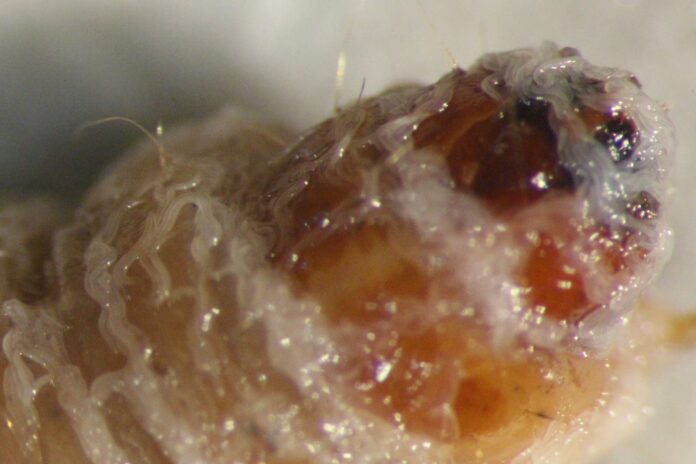The newly discovered species, named Steinernema adamsi, belongs to the Steinernema family of nematodes. This species poses no threat to humans or other mammals. Measuring slightly under 1 millimeter in length and half the breadth of a human hair, they are almost undetectable to the naked eye.
Scientists at UC Riverside have found a small kind of worm that infects and kills insects. In warm, humid environments where other beneficial nematodes are now unable to flourish, these worms, known as nematodes, may be able to reduce agricultural pests.
This new species belongs to the Steinernema family of nematodes, which has long been used in agriculture as an organic pesticide-free means of controlling insect parasites. Steinernema were originally found in the 1920s and are not dangerous to humans or other animals.
As explained by Professor of Nematology at UCR Adler Dillman: “We spray trillions of them on crops every year, and they’re easy to buy. Though there are more than 100 species of Steinernema, we’re always on the lookout for new ones because each has unique features. Some might be better in certain climates or with certain insects.”
In an attempt to learn more about a distinct species of Steinernema, Dillman’s group requested samples from colleagues in Thailand.
“We did DNA analysis on the samples and realized they weren’t the ones we had requested. Genetically, they didn’t look like anything else that has ever been described,” Dillman added.
Dillman and his team have officially documented the newfound species in the Journal of Parasitology. Its minuscule size renders it nearly imperceptible to the naked eye, measuring roughly half the width of a human hair and spanning just under 1 millimeter in length.
“Several thousand in a flask looks like dusty water,” Dillman explained.
The species has been named Steinernema adamsi in honor of Byron Adams, an esteemed American biologist who serves as the Chair of the Biology Department at Brigham Young University.
“Adams has helped refine our understanding of nematode species and their important role in ecology and recycling nutrients in the soil,” Dillman added. “He was also my undergraduate advisor and the person who introduced me to nematodes. This seemed a fitting tribute to him.”
Adams, presently engaged in nematode research in Antarctica, expressed deep honor at having a scientifically recognized species named after him, describing it as “cool” in the realm of scientific literature.
“The biology of this animal is absolutely fascinating,” Adams added. “Aside from its obvious applications for alleviating human suffering caused by pest insects, it also has much to teach us about the ecological and evolutionary processes involved in the complex negotiations that take place between parasites, pathogens, their hosts, and their environmental microbiomes.”
Dillman’s interest in researching these worms stemmed from his undergraduate studies of their life cycles. Nematodes dwell in the soil as juveniles, with their mouths shut and their growth stalled. During this stage, they roam the earth hunting for insects to infect. Once they have located a victim, they enter the mouth or anus and excrete extremely harmful germs.
“A parasite that poops out pathogenic stuff to help kill its host, that’s unusual right out of the gate,” Dillman added. “It’s like something out of a James Cameron movie.”
The insect succumbs to infection within a mere 48-hour window.
“It essentially liquefies the insect, then you’re left with a bag that used to be its body. You might have 10 or 15 nematodes in a host, and 10 days later you have 80,000 new individuals in the soil looking for new insects to infect,” Dillman noted.
The researchers are confident in S. adamsi’s ability to kill insects. They verified this by placing specimens in containers alongside wax moths.
“It killed the moths in two days with a very low dose of the worms,” Dillman noted.
The researchers want to investigate the special qualities of the nematode in the future. Its resistance to heat, UV radiation, and dryness is yet unknown. Furthermore, the variety of insects it may infect is yet unknown.
S. adamsi, however, belong to a genus that has the ability to infect hundreds of different kinds of insects. Thus, regardless of whether it proves to be a specialized or generalist parasite of several insect species, the researchers are optimistic that it will be advantageous in some way.
“This is exciting because the discovery adds another insect-killer that could teach us new and interesting biology,” Dillman added. “Also they’re from a warm, humid climate that could make them a good parasite of insects in environments where currently, commercially available orchard nematodes have been unable to flourish.”
Source:10.1645/23-60
Image Credit: Adler Dillman / UCR
